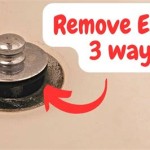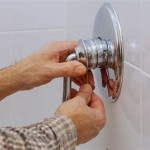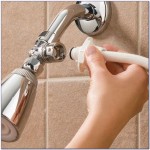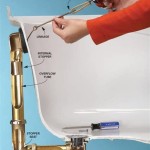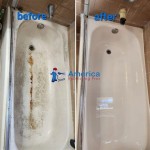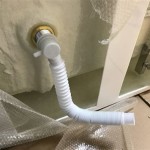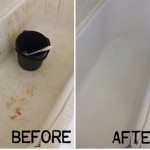Remove Rust From Bathtub Drain
Rust in a bathtub drain is a common problem, particularly in homes with older plumbing systems or those using hard water. The discolored, flaky residue is not only unsightly but can also contribute to drain clogs and, over time, compromise the structural integrity of the drain components. Understanding how rust forms, identifying the right tools and materials, and implementing effective removal methods are crucial for maintaining a functional and aesthetically pleasing bathroom.
The formation of rust is a chemical process known as oxidation. It specifically refers to the oxidation of iron, where iron molecules react with oxygen in the presence of water or moisture to create iron oxide (Fe2O3), the reddish-brown substance we recognize as rust. In a bathtub drain, several factors contribute to rust development. The drain components themselves may be made of iron or steel alloys that are susceptible to corrosion. Hard water, which contains high levels of minerals like calcium and magnesium, can accelerate the rusting process. Furthermore, the constant exposure to water and humidity in the bathroom environment provides the ideal conditions for oxidation to occur.
Identifying the presence and extent of rust in a bathtub drain is the first step in addressing the problem. Visually inspect the drain opening, stopper, and any visible drain components for reddish-brown discoloration or flaking. Look closely at areas where water tends to pool or where the drain components connect. If the rust is superficial, it may simply be a surface stain. However, if the rust is thick, flaky, or causes pitting, it indicates a more severe level of corrosion that may require more aggressive removal methods or even drain replacement.
Before attempting to remove rust, it is important to gather the necessary tools and materials. Safety should always be the top priority. Wear rubber gloves to protect the hands from chemicals and sharp edges. Eye protection, such as safety glasses, should be worn to prevent rust particles or cleaning solutions from splashing into the eyes. A respirator or dust mask may be necessary if the rust is particularly flaky or if using abrasive removal methods that generate dust. Regarding tools, a screwdriver set (both Phillips and flathead) will be needed to remove drain stoppers and other components. A wire brush with stiff bristles is useful for scrubbing away rust. Steel wool or abrasive pads can provide additional scrubbing power. Pliers or a wrench may be required to loosen stubborn drain parts. A container (such as a bucket or bowl) will be necessary to catch debris and cleaning solutions. Finally, have old rags or paper towels on hand for cleaning up spills and drying surfaces.
A variety of cleaning agents can be used to remove rust from a bathtub drain, ranging from household solutions to commercially available rust removers. The choice of cleaning agent depends on the severity of the rust and the materials of the drain components. Mild rust can often be removed with simple household ingredients such as vinegar, baking soda, or lemon juice. These substances are acidic and can help dissolve rust without damaging the drain. For more stubborn rust, stronger cleaners like oxalic acid or commercially available rust removers may be necessary. When using chemical rust removers, carefully follow the manufacturer's instructions and take appropriate safety precautions to avoid skin and eye irritation.
Using Vinegar to Remove Rust
Vinegar, particularly white vinegar, is a readily available and relatively mild acid that can effectively remove light rust. To use vinegar, first remove the drain stopper and any other removable drain components. Pour undiluted white vinegar directly onto the rusted areas of the drain. Allow the vinegar to soak for several hours or even overnight. The acidic nature of the vinegar will help loosen the rust. After soaking, scrub the rusted areas with a wire brush or steel wool. Rinse the drain thoroughly with water to remove any remaining vinegar and rust particles. Repeat the process if necessary. Vinegar is a good option for initial attempts at rust removal due to its low cost and minimal risk of damaging drain components. However, it may not be effective for heavy rust buildup.
Utilizing Baking Soda Paste
Baking soda, a common household item, can be used to create a paste that helps remove rust through its mild abrasive and alkaline properties. Mix baking soda with water to form a thick paste. Apply the paste to the rusted areas of the drain and allow it to sit for several hours. The baking soda will help to loosen the rust. After soaking, scrub the drain with a wire brush or steel wool. Rinse the drain thoroughly with water. Baking soda is less corrosive than vinegar and is a good option for cleaning more delicate drain components. The paste's abrasive properties also help physically remove the rust. For heavily rusted areas, baking soda can be combined with vinegar for a more potent cleaning action. The combination creates a fizzing reaction that helps to dislodge rust particles.
Employing Commercial Rust Removers
For severe rust, commercially available rust removers may be necessary. These products typically contain stronger acids or chelating agents that dissolve rust more effectively than household cleaners. When using commercial rust removers, meticulously follow the manufacturer's instructions. These products can be corrosive and may damage certain drain materials if used improperly. Before applying the rust remover, test it in an inconspicuous area of the drain to ensure it doesn't cause discoloration or degradation. Wear rubber gloves and eye protection during application. Apply the rust remover to the affected areas and allow it to sit for the recommended amount of time. Scrub the drain with a wire brush or steel wool, and then rinse thoroughly with water. Ensure adequate ventilation when using commercial rust removers, as some products may release harmful fumes.
In some cases, removing rust from a bathtub drain may require disassembling the drain components. This can provide better access to rusted areas and allow for more thorough cleaning. Before disassembling the drain, take photographs or make a diagram to help you remember how the parts fit together. This will simplify the reassembly process. Carefully loosen and remove the drain stopper, strainer, and any other visible drain components. Clean each component individually using one of the methods described above. Inspect the drain components for signs of severe corrosion or damage. If components are extensively rusted, consider replacing them with new ones. After cleaning or replacing the drain components, reassemble the drain, ensuring that all parts are properly aligned and tightened. Test the drain to ensure it is functioning correctly and that there are no leaks.
Preventing rust formation in a bathtub drain is often easier than removing it. Several preventative measures can be taken to minimize the risk of rust. Regularly clean the drain to remove soap scum, hair, and other debris that can trap moisture and accelerate corrosion. Use a drain strainer to prevent large objects from entering the drain. Periodically flush the drain with hot water to help dissolve mineral deposits and prevent rust from forming. Consider using a water softener if the home has hard water. Water softeners remove minerals that contribute to rust and scale buildup. Apply a rust-inhibiting coating to the drain components. These coatings create a protective barrier that prevents moisture from reaching the metal surfaces. Regularly inspect the drain for signs of rust and address any problems promptly to prevent them from escalating.
If, despite best efforts, the rust in a bathtub drain persists or the drain components are severely damaged, it may be necessary to replace the drain. Replacing a bathtub drain is a moderately complex plumbing task that may require the assistance of a professional plumber. However, with the right tools and knowledge, it can be done as a DIY project. Before starting the replacement, turn off the water supply to the bathroom. This will prevent accidental flooding during the drain replacement. Remove the existing drain components, including the drain stopper, strainer, and drain flange. Clean the area around the drain opening to remove any debris or old sealant. Apply plumber's putty or silicone sealant to the new drain flange to create a watertight seal. Insert the new drain flange into the drain opening and tighten the mounting nut from underneath the bathtub. Connect the new drain to the existing drainpipe. Test the drain to ensure it is functioning correctly and that there are no leaks. Following these steps can help ensure a successful drain replacement and prevent future rust problems.

3 Easy Ways To Remove Rust From A Bathtub Wikihow

Fix And Prevent Corrosion On A Bath Tub Drain Hometalk

3 Easy Ways To Remove Rust From A Bathtub Wikihow

How To Remove Rust Stains From Sink Tub Mr Handyman

3 Easy Ways To Remove Rust From A Bathtub Wikihow

How Do I Clean A Rusty Bathtub Hometalk

Rust In Bath Tub Hometalk

Bathtub Drain Repair How To Remove Rust Doityourself Com

Rust In Bath Tub Hometalk

Home Cleaning Ehow How To Remove Rust Stains S
Related Posts

